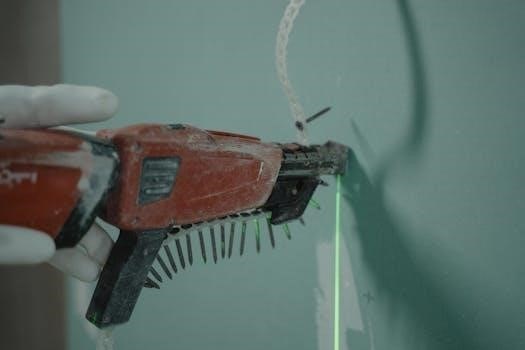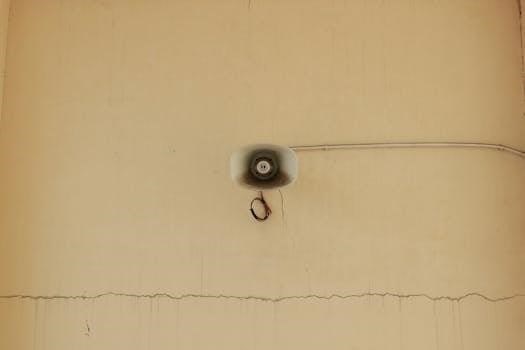Embarking on a TV wall mount installation project can greatly enhance your viewing experience and save space. This guide provides essential information, drawing from installation manuals and DIY insights. Secure attachment to the vertical wall is crucial, preventing potential injury or damage.
Importance of Following a Guide
Adhering to a comprehensive installation guide is paramount for a successful and safe TV wall mounting endeavor. These guides, often in PDF format, provide step-by-step instructions tailored to your specific TV and wall mount model. Neglecting these instructions can lead to improper installation, potentially causing the TV to fall, resulting in damage to the device and possible injuries.
Manufacturers design their mounts with specific weight and size limitations in mind. The guide will clearly outline these specifications, ensuring compatibility. Furthermore, it details the necessary tools and hardware required, preventing frustrating interruptions during the installation process. Detailed diagrams and illustrations within the guide clarify complex steps, minimizing the risk of errors.
Following the guide also ensures that the mount is securely attached to the wall studs or appropriate anchors are used, guaranteeing stability. Safety precautions are outlined, emphasizing the importance of having assistance, especially for larger TVs. By meticulously following the guide, you can confidently complete the installation, knowing that your TV is securely and safely mounted, providing years of viewing pleasure. Ultimately, the guide acts as your roadmap to a professional-looking and secure TV wall mount.
Overview of Common TV Wall Mount Types
Selecting the appropriate TV wall mount is crucial for achieving the desired viewing experience and aesthetic. Fixed mounts offer a low-profile option, positioning the TV close to the wall, ideal for stationary viewing angles. Tilting mounts allow for slight vertical adjustments, reducing glare from lights or windows, enhancing viewing comfort.
Full-motion mounts provide the most flexibility, enabling swivel and extension capabilities, perfect for versatile viewing angles from various locations in the room. These mounts are particularly useful for corner installations or when needing to access the back of the TV for cable management. Each type caters to specific needs and preferences.
Consider the TV size, weight, and VESA compatibility when choosing a mount. VESA patterns are standardized mounting hole measurements on the back of TVs. Ensure the mount’s VESA compatibility matches your TV. Also, confirm the mount’s weight capacity exceeds your TV’s weight to guarantee safety and stability. Understanding the characteristics of each mount type empowers you to make an informed decision, resulting in an optimal viewing setup. Remember to consult your TV’s manual for specific mounting recommendations.

Preparation and Safety Precautions
Before installation, check your TV’s compatibility and VESA standards. Gather necessary tools and materials, and prioritize safety measures. Always have assistance and consult professionals for wall structure concerns to prevent accidents.
Checking TV Compatibility and VESA Standards
Before commencing any TV wall mount installation, a critical first step involves verifying the compatibility of your television with the intended mounting system. This process hinges significantly on understanding and checking the Video Electronics Standards Association (VESA) standards. VESA patterns, standardized mounting hole configurations located on the back of TVs, dictate compatibility with various wall mounts.
Consult your TV’s specifications, often found in the product manual or on the manufacturer’s website, to ascertain its VESA compatibility. Pay close attention to the VESA pattern dimensions, typically expressed in millimeters (e.g., 200x200mm, 400x400mm). Ensure that the wall mount you intend to use supports the specified VESA pattern of your TV. Furthermore, verify that the TV’s weight falls within the weight capacity of the wall mount.
Ignoring these compatibility checks can lead to instability, potential damage to your TV or wall, and even safety hazards. Some wall mounts offer wide VESA pattern compatibility, working with most TV brands and sizes, but always confirm before proceeding. If your TV requires inset spacers or wall mount adapters, consult the troubleshooting section of your mount’s installation manual.
Gathering Necessary Tools and Materials
Prior to initiating the TV wall mount installation, assembling the correct tools and materials is paramount for a smooth and secure process. A well-prepared toolkit minimizes delays and ensures accurate execution. Essential items include a stud finder, crucial for locating wall studs to provide secure anchor points; In cases where studs are inaccessible, appropriate wall anchors are necessary, selected based on wall type and TV weight.
A level is indispensable for achieving a perfectly horizontal TV placement. A drill with various drill bits is needed for creating pilot holes and securing screws. Screwdrivers, both Phillips head and flathead, are required for tightening screws on the mount and TV brackets. A measuring tape aids in accurate placement and alignment. Safety glasses are essential for eye protection during drilling and screwing.
Furthermore, gather the TV wall mount kit itself, ensuring it contains all necessary hardware, such as screws, bolts, and washers. Depending on your specific setup, cable management solutions like zip ties or cable sleeves might be beneficial for organizing wires. Finally, having a pencil for marking measurements and a clean cloth for wiping surfaces will contribute to a professional and organized installation.
Safety Measures During Installation
Prioritizing safety during TV wall mount installation is essential to prevent injuries and ensure a secure setup. Begin by disconnecting the TV from the power outlet to eliminate the risk of electrical shock. Always have at least two people assist with lifting and mounting the TV, especially for larger screens, to avoid strain or accidental drops.
Wear safety glasses to protect your eyes from dust and debris generated during drilling. When using power tools, ensure they are in good working condition and follow the manufacturer’s instructions carefully. Before drilling, double-check the location for any hidden wiring or plumbing to prevent damage and potential hazards.
Use a stud finder to accurately locate wall studs, and select appropriate mounting hardware based on the wall type and TV weight. If using wall anchors, ensure they are rated to support the TV’s weight with a significant safety margin. Avoid over-tightening screws, which can strip threads or damage the wall. Finally, keep the work area clear of obstacles and ensure proper ventilation when using power tools. Taking these precautions minimizes risks and promotes a safe installation process.

Step-by-Step Installation Process
The installation process involves several key steps⁚ locating wall studs, attaching brackets to the TV, mounting the wall plate securely, and finally, carefully hanging the TV onto the mounted wall plate for a secure fit.
Locating Wall Studs or Using Anchors
The initial and vital step in securely mounting your TV involves accurately locating wall studs. These studs provide the necessary structural support to hold the weight of your television. Use a stud finder to precisely identify their position within the wall. Mark the stud locations clearly with a pencil for easy reference during the mounting process.
If wall studs are not accessible or suitably positioned for your desired TV placement, employing wall anchors becomes essential. Wall anchors are designed to provide a secure hold in drywall or other hollow wall materials. Select anchors that are appropriately rated to support the weight of your TV and the mounting bracket.
Carefully follow the manufacturer’s instructions for installing the chosen wall anchors. Ensure they are properly inserted and tightened to maximize their holding capacity. When working with cinder block walls, verify the concrete thickness is adequate before installing any anchors. If unsure, consult a construction professional for advice on suitable mounting solutions for your wall structure. Proper stud location or anchor installation is crucial for a safe and secure TV mount.
Attaching Brackets to the TV
Once you have located the wall studs or prepared your anchors, the next crucial step involves securely attaching the mounting brackets to the back of your television. Begin by carefully identifying the correct VESA (Video Electronics Standards Association) pattern for your TV. This pattern refers to the standardized hole configuration on the back of the TV used for mounting.
Consult your TV’s manual or measure the distance between the mounting holes to determine the VESA pattern. Select the appropriate screws and spacers included with your wall mount kit that match your TV’s VESA specifications. Attach the brackets to the TV using the selected screws, ensuring they are tightened securely but not over-tightened to avoid damaging the TV.
If your TV has inset spacers or wall mount adapters, refer to the troubleshooting section of your wall mount’s manual for specific instructions. Ensure the brackets are aligned properly and flush against the back of the TV. This will provide a stable and secure connection point for mounting the TV to the wall plate.
Mounting the Wall Plate
With the brackets securely attached to your TV, the next crucial step is mounting the wall plate. This is where the stability and safety of your entire installation hinge. Align the wall plate against the wall, ensuring it is centered at your desired viewing height. Use a level to guarantee the plate is perfectly horizontal; this is critical for a straight and visually appealing final result.
If you located wall studs in the previous step, position the wall plate so that its mounting holes align directly with the studs. Use lag bolts to secure the plate directly into the studs, ensuring a robust and reliable connection. If studs are not available or are not ideally positioned, use appropriate wall anchors designed for the weight of your TV and mount.
Follow the anchor manufacturer’s instructions carefully, drilling pilot holes and inserting the anchors securely. Then, attach the wall plate to the anchors using the provided screws. Double-check that the wall plate is level and firmly attached to the wall before proceeding.
Hanging the TV on the Wall Plate
With the wall plate securely mounted, the exciting moment of hanging the TV arrives. This step ideally requires two people for safety and ease. Carefully lift the TV, aligning the brackets attached to the back with the corresponding slots or hooks on the wall plate. Gently guide the TV onto the wall plate, ensuring the brackets engage securely.
Some wall mounts feature a locking mechanism; ensure it is properly engaged to prevent accidental dislodging. Once the TV is hanging, take a step back to visually assess its position. It should appear level and centered. If adjustments are needed, most mounts allow for slight horizontal or vertical shifts.
Refer to your mount’s instructions for specific adjustment procedures. Once satisfied with the TV’s position, double-check all connections and locking mechanisms. Ensure the TV is stable and secure before fully releasing your grip. This step marks a significant milestone in your TV wall mount installation.

Final Adjustments and Cable Management
After mounting, leveling the TV and managing cables are vital. Adjust the tilt to your preference, typically under 15 degrees. Organize cables for proper ventilation. Standard dimensions are in the guide.
Leveling the TV and Adjusting Tilt
Once the TV is securely mounted on the wall plate, the next crucial step involves ensuring it is perfectly level and adjusting the tilt for optimal viewing. Begin by using a level tool to check the horizontal alignment of the TV. Place the level along the top edge of the TV and make necessary adjustments to the wall mount brackets until the bubble indicates a perfectly level position. Many wall mounts offer slight adjustments that can be made to fine-tune the level.
If your wall mount allows for tilt adjustment, now is the time to set the desired angle. A slight downward tilt can improve viewing angles, especially when the TV is mounted higher on the wall. However, it is crucial to avoid tilting the TV more than 15 degrees, as this can strain the mount and potentially compromise its stability. Secure the tilt adjustment mechanism once you have achieved the desired angle, following the manufacturer’s instructions carefully. Double-check all adjustments to ensure they are secure and that the TV remains stable in its final position. Proper leveling and tilt adjustment are essential for a comfortable and visually pleasing viewing experience.
Organizing Cables and Ventilation
After leveling the TV and adjusting its tilt, the final step involves organizing the cables and ensuring proper ventilation. Begin by gathering all the cables connected to your TV, such as HDMI cables, power cords, and any other necessary connections. Use cable ties, Velcro straps, or cable sleeves to bundle the cables together, creating a neat and organized appearance. Run the cables along the wall, concealing them as much as possible. Cable management kits can be helpful for hiding cables within the wall or along the baseboards.

Equally important is ensuring proper ventilation for your TV. TVs generate heat, and inadequate ventilation can lead to overheating and potential damage. Make sure there is sufficient space around the TV for air to circulate freely. Avoid blocking any ventilation openings on the back of the TV. If necessary, consider using a wall mount that provides extra space between the TV and the wall to improve airflow. By organizing cables and ensuring proper ventilation, you can enhance the aesthetics of your setup and prolong the lifespan of your TV.
